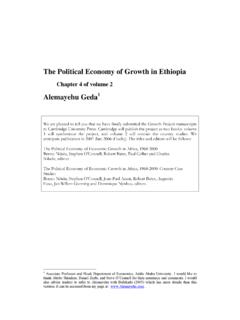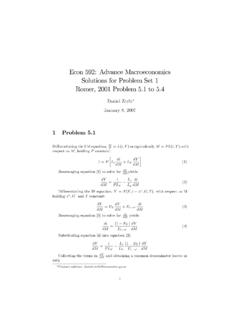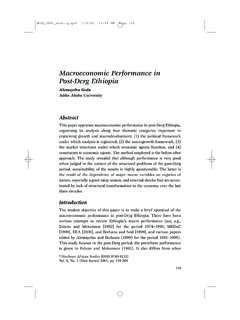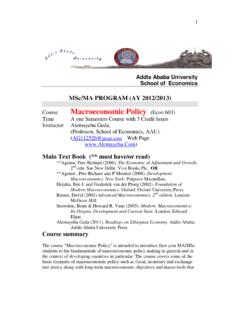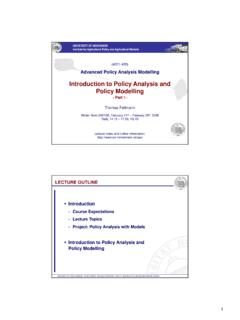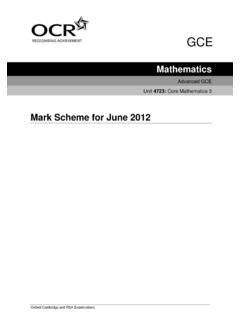Transcription of Policy Analysis ASSESSING POLICY ALTERNATIVES
1 1 ASSESSING POLICY ALTERNATIVES After identifying ALTERNATIVES we have to ask: Which POLICY alternative should be adopted? POLICY Analysis In this step in the POLICY Analysis process, the POLICY analyst takes each of the proposed POLICY ALTERNATIVES and, one by one, applies each of the decision criteria to each alternative. Step 1:specify the criteria that is to be used ( efficiency, cost, political acceptability, and equity). Step 2:define what you mean by each of these criteria and how Advanced POLICY Analysis Modelling - Thomas Fellmann, University of Hohenheim, Institute for Agricultural POLICY and Agricultural Markets, Germany they will be measured. Step 3:look at each proposed POLICY alternative, one at a time, and ask, what would be the efficiency, cost etc.
2 Of this alternative? But: how do we know what, the efficiency of each alternative will be?FORECASTING The criteria that will be important in ASSESSING the proposed POLICY ALTERNATIVES determine what needs to be Analysis - ASSESSING POLICY ALTERNATIVES There are a variety of methods used to make forecasts. They range from simple stereotyping to complex statistical formulas. Intuitionmay use techniques such as Delphi, scenario writing, or feasibility assessment. However, it requires that the participants be quite knowledgeable, and it needs to be checked for logical consistencyAdvanced POLICY Analysis Modelling - Thomas Fellmann, University of Hohenheim, Institute for Agricultural POLICY and Agricultural Markets, Germany consistency.
3 Theoretical modelsidentify important variables and specify the nature of the linkages among them. Then the model is used to predict outcomes when one or more of the variables are changed. Models are built from information, experience, expert advice, etc. 2 FORECASTING(contd.) Constructing a modelhelps to get to the key elementsPolicy Analysis - ASSESSING POLICY AlternativesConstructing a modelhelps to get to the key elements of the situation, and focus on the most important concerns. It identifies the key factors and the relationships among them which will likely be impacted by any proposed POLICY alternative. In a model we demonstrate the likely consequences of either the no action alternative or any other rival alternativeAdvanced POLICY Analysis Modelling - Thomas Fellmann, University of Hohenheim, Institute for Agricultural POLICY and Agricultural Markets, Germany no action alternative, or any other rival alternative.
4 Models may be expressed in words, in physical dimensions ( , architectural models), or in numerical form. FORECASTING(contd.) Extrapolationuses the past to predict the future, assuming there are stable Analysis - ASSESSING POLICY ALTERNATIVES Extrapolation is useful for conducting a baseline Analysis , showing what is expected if the status quo or no action alternative is adopted. It is relatively simple and cheap and can be accurate in many circumstances. Data can be either raw numbers or a computed rate of change. Advanced POLICY Analysis Modelling - Thomas Fellmann, University of Hohenheim, Institute for Agricultural POLICY and Agricultural Markets, Germany Extrapolation requires precise definitions of criteria and measures, and accurate measurement.
5 It is most often used when there are linear patterns in the data. Extrapolation is less useful in the case of new problems, new issues, or new POLICY areas, where there is little or no past (contd.) The most commonly used form of regression is linear regression. Linear regression uses the values from an existing data set POLICY Analysis - ASSESSING POLICY Alternativesconsisting of measurements of the values of two variables, X and Y, to develop a model that is useful for predicting the value of the dependent variable, Y for given values of X. Elements of a Regression Equation:The regression equation is written as: Y = a + bX + e Y= Dependent variable (Y), what is being predicted or explained Advanced POLICY Analysis Modelling - Thomas Fellmann, University of Hohenheim, Institute for Agricultural POLICY and Agricultural Markets, Germany p(),gppa = Alpha, a constant; equals the value of Y when the value of X=0 b = Beta, the coefficient of X; the slope of the regression line; how much Y changes for each one-unit change in X.
6 X = Independent variable (X), what is predicting or explaining the value of Y e = The error term; the error in predicting the value of Y, given the value of X (it is not displayed in most regression equations). FORECASTING(contd.)Linear regression example: We know what the population has been in past years for a given Analysis - ASSESSING POLICY ALTERNATIVES We can compute the values of the components of the regression equation, and use them to predict what the area's population will be in future years. But: If the data are not linear, that is, if on a graph th lith t b t hthl tihi b tYear ActualPopulation1910 1920 1930 1940 1950 1960 Advanced POLICY Analysis Modelling - Thomas Fellmann, University of Hohenheim, Institute for Agricultural POLICY and Agricultural Markets, Germany the line that best shows the relationship between the two variables is not a straight line, then simple linear regression cannot be used to extrapolate into the future.
7 Instead, the data must be converted, to 1980 1990 => Predicted population:2000 2010 4 ECONOMIC Analysis One of the most widely used economic Analysis tools is to look at the long term costsand the long term benefitsof a proposed POLICY POLICY Analysis - ASSESSING POLICY Alternativesalternative. - From there, the POLICY analyst can calculate either the Net Present Value (NPV), the Cost-Benefit Ratio, or the Internal Rate of Return (IRR) of each alternative. The POLICY analyst must assemble estimates of the initial or implementation year costs and benefitsof the alternative, and the Advanced POLICY Analysis Modelling - Thomas Fellmann, University of Hohenheim, Institute for Agricultural POLICY and Agricultural Markets, Germany subsequent costs and values for each additional yearthe project will be in effect.
8 Example:YEAR: 0 1 2 3 4 5 Costs $15,000 0 0 $1,223 0 0 Benefits0 $4,000 $4,000 $4,000 $4,000 $4,000 ECONOMIC Analysis - DISCOUNTING next step for the POLICY analyst: decide on a discount rate. DThe discount rate assumes that money spent in the future will notPolicy Analysis - ASSESSING POLICY AlternativesDThe discount rate assumes that money spent in the future will not cost as much as money spent today. DSimilarly, money gained in the future will not be worth as much as money gained today. DThis is based on the human preference for wanting to put off costs (or payments) as long as possible, and wanting to receive benefits ()iblAdvanced POLICY Analysis Modelling - Thomas Fellmann, University of Hohenheim, Institute for Agricultural POLICY and Agricultural Markets, Germany (or pay) as soon as possible.
9 The discount rate is usually obtained from economists, from agency POLICY , or from the nature of the project being Another source is the discount rate charged by the Federal Bank, or the interest rate paid on government Analysis DISCOUNTING (contd.) At times, the choice of which discount rate to use has been highly politicized. POLICY Analysis - ASSESSING POLICY AlternativespDMany government projects have high initial costs but a long stream of benefits Da low discount rate will make a project look more favourable Da high discount rate will make a project look less favourable The same discount rate is generally applied to both, the project Advanced POLICY Analysis Modelling - Thomas Fellmann, University of Hohenheim, Institute for Agricultural POLICY and Agricultural Markets, Germany costs and the project benefits.
10 If inflation is going to be factored in, it should be applied to both the costs and benefits separately, before the discount factor is Analysis DISCOUNTING (contd.) POLICY Analysis - ASSESSING POLICY AlternativesYEAR: 0 1 2 3 4 5 Total Costs $15,000 0 0 $1,223 0 0 $16,223 To calculate the discounted costs, lti lh'tDiscount rate 4% 4% 4% 4% 4% 4% Discount factor .9615 .9246 .8890 .8548 .8219 Discounted costs $15,000 0 0 $1087 0 0 $16,087 YEAR.
![Curriculum Vitae [1-April-97] - ::: …](/cache/preview/8/3/8/4/2/2/5/2/thumb-8384225265b34eac0963e7f7ecd24ea6.jpg)
